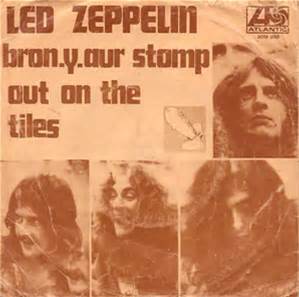The Welsh period. After the mayhem of 5 US Tours and the media scrum following the success of 'Led Zeppelin II', they needed to rest and reflect. Robert recalled a place from his youth, Bron-Y-Aur, a cottage, where he and Jimmy could both relax and work, to see if they could write in the simplest, purest way.
A sideways move, some hankering for Whole Lotta Love parts 2,3 & 4 would call it a backwards move. In hindsight for us fans and observers, a masterstroke.
The instrumental 'Bron-Y-Aur' was conceived at the cottage for sure, and recorded at Island Studios, probably in early July 1970 alongside Gallows Pole. A haunting and evocative instrumental, Jimmy weaves two acoustic guitars together to create a wonderful sonic landscape. The mix, with slight phasing between the two channels, adds an ambience for sure. A reflective aural tribute to the cottage that made Led Zeppelin take a left turn and helped secure a wide open musical future.
The various convoluted rehearsal tapes from this period include snippits and takes of Jimmy contructing this instrumental during May and early June.
Come the 6th US Tour it was included as part of a brief acoustic interlude, alongside 'That's The Way', and there are 8 recorded bootleg tapes to attest. The most famous is the 'Live On Blueberry Hill' L A Forum September 4th show where Robert talks at length by way of introduction, explaining the translation for the Welsh name is 'Golden Breast'. Never as evocative as the studio version, it was never played onstage again.
In contrast 'Bron-Y-Aur Stomp' is an uplifting celebration of good times around the hearth, flagons of cider and mead and the odd herbal cigarette. With backing vocals and assorted Bonzo percussion it's a joyous song that takes you into the Welsh mountains.
Months earlier, on December 13th 1969 Led Zeppelin laid down a rollicking electric backing track in Olympic No 2 provisionally titled 'Jennings Farm Blues'. A Riff Jimmy was fascinated enough with to obsessively repeat until exhaustion, and once the backing track was as he wanted it was time to add layers of overdubbed guitars weaving in and around the main theme. This was heady and electric but ultimately unfinished.
Named after Robert's farm property at the time, it curiously is an instrumental with Jimmy grabbing the moment and adding stream of interweaving electric overdubs.
We have several rehearsal attempts, and the final run through where those guitar overdubs are employed to magical effect. A Bootleg favourite for over 20 years, an official version finally appeared on the companion disc of Coda.
By the time 'III' was being assembled the picking country riff was recorded as an acoustic hoedown, Robert dedicating it to his 'blue eyed merle' Stryder.
Robert at Jennings Farm
Months earlier, on December 13th 1969 Led Zeppelin laid down a rollicking electric backing track in Olympic No 2 provisionally titled 'Jennings Farm Blues'. A Riff Jimmy was fascinated enough with to obsessively repeat until exhaustion, and once the backing track was as he wanted it was time to add layers of overdubbed guitars weaving in and around the main theme. This was heady and electric but ultimately unfinished.
Named after Robert's farm property at the time, it curiously is an instrumental with Jimmy grabbing the moment and adding stream of interweaving electric overdubs.
We have several rehearsal attempts, and the final run through where those guitar overdubs are employed to magical effect. A Bootleg favourite for over 20 years, an official version finally appeared on the companion disc of Coda.
By the time 'III' was being assembled the picking country riff was recorded as an acoustic hoedown, Robert dedicating it to his 'blue eyed merle' Stryder.
Live, Jimmy teased the riff during intro's to That's The Way in Japan 1971, but it was only formally added to the acoustic set for the 8th US Tour in 1972.
Played pretty straight, it was a Robert Plant communion number nonetheless. 11 versions exist from that tour. For Japan '72 and Britain/Europe '72 and '73 it was the only acoustic piece, possibly designed to loosen the atmosphere and lighten the mood.
Not seen again until Earls' Court it was more relaxed and expanded with Bonzo adding spoons to great effect.
It then became the finale of the long Magick 11th US Tour acoustic interlude, by now extended to include long solo indulgencies by Jimmy and occasional stand-up Bass figures by John Paul Jones. Even Mac The Knife got a look in at one point!
It then became the finale of the long Magick 11th US Tour acoustic interlude, by now extended to include long solo indulgencies by Jimmy and occasional stand-up Bass figures by John Paul Jones. Even Mac The Knife got a look in at one point!
There are a handful of singles from around the world with this on the b-side, and a plethora of Polish Postcard Flexi's too
Spelling wise, there has always been confusion about it being bron-y-aur or bron-yr-aur. The band spell it without the 'r', official Welsh sites with. Go figure. Various releases of both songs over the years have used both spellings.
A memory of happy carefree times for band and fans alike.







Great post! I love the breakdowns of the evolution of the songs, throughout their career. May favorite version of the instrumental number Bron-Y-Aur is 9/19/70. Those harmonics give me shivers.
ReplyDeleteThanks for writing.